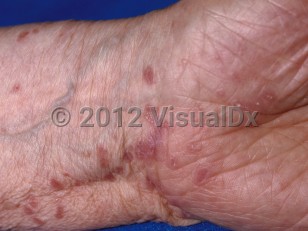Lichen planus - Nail and Distal Digit
See also in: Overview,AnogenitalAlerts and Notices
Important News & Links
Synopsis

Nail involvement occurs in less than 25% of patients with skin or mucosal disease. Isolated nail involvement can also be the first or only manifestation of the disease, but isolated nail LP is relatively uncommon. Clinical features depend on the location, duration, and severity of the disease in the nail apparatus. Involvement of the entire nail matrix is the most frequent presentation and results in thinning of the nail plate, onychorrhexis, nail atrophy with dorsal pterygium formation, and trachyonychia. Focal nail matrix involvement produces longitudinal splitting, longitudinal ridging, and pitting. Involvement of the nail bed is rare and induces distal subungual hyperkeratosis with or without associated onycholysis. If untreated, permanent scarring of the nail matrix may occur, resulting in dorsal pterygium formation.
LP is a cause of twenty-nail dystrophy, which is more commonly seen in children than adults. LP has been reported as a cause of longitudinal melanonychia.
Typically the diagnosis of nail LP is delayed, and many patients will have changes for more than 3 years before the diagnosis is made.
LP is more common in adults, and prevalence in children is 2%-3%.
Codes
L43.9 – Lichen planus, unspecified
SNOMEDCT:
4776004 – Lichen planus
Look For
Subscription Required
Diagnostic Pearls
Subscription Required
Differential Diagnosis & Pitfalls

Subscription Required
Best Tests
Subscription Required
Management Pearls
Subscription Required
Therapy
Subscription Required
Drug Reaction Data
Subscription Required
References
Subscription Required
Last Updated:05/31/2020
 Patient Information for Lichen planus - Nail and Distal Digit
Patient Information for Lichen planus - Nail and Distal Digit- Improve treatment compliance
- Reduce after-hours questions
- Increase patient engagement and satisfaction
- Written in clear, easy-to-understand language. No confusing jargon.
- Available in English and Spanish
- Print out or email directly to your patient



